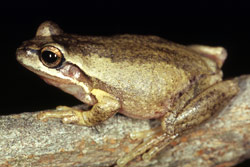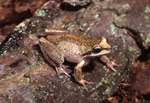Litoria paraewingi
Victorian Frog
Also: False Ewing's Tree Frog, Plains Brown Tree Frog

+ 40 kb Victorian Frog (Litoria paraewingi)
A close relative of Litoria ewingi with which it is often confused, but whose distributions do not overlap. Described only in 1971 when differences in call between L. ewingi and this frog were discovered.
Distribution and habitat

Adults frequent woodlands, open and disturbed areas including alpine habitats. Eggs and tadpoles can be found in slow-flowing creeks or backwaters of rivers, still water in ponds, roadside ditches, dams and lakes.
There is a detailed distribution map available for: Victoria.
Calling
Males call in water floating among vegetation or from the ground, or in low vegetation. The call is a series of 3-7 slowly repeated whirring notes - "creeee creee cree cree" - similar to but slower than the call of Litoria ewingi.
Copyright Murray Littlejohn. Recorded by Murray Littlejohn. Must not be reproduced without permission.
Life cycle

Distinguishing characteristics

+ 36 kb Victorian Frog (Litoria paraewingi)
Adult
length: 20-40mm.
The eggs are pigmented in jelly clumps are usually attached to submerged vegetation. The tadpoles are pale golden-yellow to dark grey with dark flecked fins. Adults are light brown or grey with paler sides. Breeding males have a light brown vocal sac.
Visible features
Presented here is the information stored in the frogs.org.au database which is used to identify frogs based on their appearance. It is intended to be used in a key guide for separating species so some of the information (for example, back colours) may be rather non-specific. The system is currently being developed - if you notice errors in the data, please write to Dave Black at the address at the bottom of the page.
Important note: This information details only the appearance of the frog. If an "or" appears in the description, this may mean either that there is some variation within the species or that the feature might be observed differently by different people. For example, if a frog has very small toe pads, it may be listed as having "Toe pads: present or absent".
Size
Up to between 30mm and 60mm
Eyes, hands, and feet
Pupils: horizontal
Toe pads: present
Webbing on feet: half-webbing
Belly
Texture: smooth
Pattern: plain
Colour: single colour
Back
Texture: smooth or rough
Pattern: plain or mixed / marbled
Colour: single colour or multi-coloured
Glands and tubercles
Parotoid gland: absent
Tibial gland: absent
Metatarsal tubercles: absent
Similar species (note: this version was written for Victorian species).
Separated from Litoria ewingi only by call and distribution, although Litoria paraewingi is generally smaller. Can be readily distinguished from Litoria verreauxi by having toe pads broader than its digits and by the absence of large black or dark blotches in its groin, and from Litoria lesueuri by having a hidden or indistinct tympanum (ear).
Litoria paraewingi image gallery
The scientific names of Litoria paraewingi
- Litoria paraewingi (Watson, Loftus-Hills & Littlejohn 1971)


